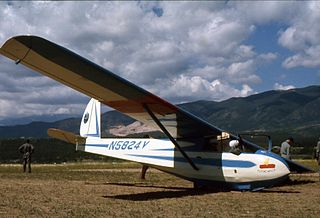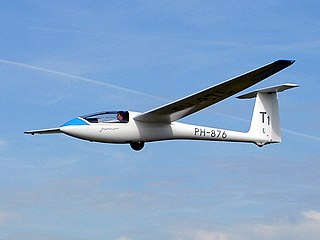
The Bensen B-8 is a small, single-seat autogyro developed in the United States in the 1950s. Although the original manufacturer stopped production in 1987, plans for homebuilders are still available as of 2019. Its design was a refinement of the Bensen B-7, and like that aircraft, the B-8 was initially built as an unpowered rotor-kite. It first flew in this form in 1955, and on 6 December a powered version, designated B-8M first flew. The design proved to be extremely popular and long-lasting, with thousands of sets of plans sold over the next thirty years.

The Valmet PIK-23 Towmaster or Suhinu is a Finnish two-seato glider towing/primary trainer aircraft built entirely out of composite materials in the early 1980s.

The DFS 331 was a transport glider prototype developed in a collaboration between DFS and Gotha. It was a twenty-seat troop transport designed by Hans Jacobs, who had previously produced the successful, nine seat DFS 230.

The PZL S-4 Kania 2 was a Polish trainer and glider towing aircraft of the 1950s, not built in series. The first prototype was designated S-3 Kania. There is also a helicopter named PZL Kania.

The Waco CG-4 was the most widely used American troop/cargo military glider of World War II. It was designated the CG-4A by the United States Army Air Forces, and named Hadrian in British military service.

The Waco CG-13 was an American military transport glider aircraft developed during World War II.

The EAA Biplane is a recreational aircraft that was designed in the United States in the late 1950s and marketed as plans for homebuilding.
The Flight Dynamics Flightsail VII was a recreational aircraft marketed in the United States in the 1970s for homebuilding by Flight Dynamics, Inc., most unusual both in its design and its method of construction. The Flightsail VII was intended to be built in three stages, with each stage representing a flyable aircraft of increasing complexity, capability, and cost. It was hoped that this approach would appeal to homebuilders by minimizing the amount of time and money required to take the aircraft to a point where it could be flown.

The Schweizer SGS 2-8 is an American two-seat, mid-wing, strut-braced, training glider built by Schweizer Aircraft of Elmira, New York.

The Schweizer SGU 2-22 is an American two-seat, high-wing, strut-braced, training glider built by Schweizer Aircraft of Elmira, New York.

The Heath Parasol is an American single-seat, open-cockpit, parasol winged, homebuilt monoplane.

The SZD-6x Nietoperz was a single-seat tail-less experimental glider aircraft that was designed and built in Poland at Szybowcowy Zakład Doświadczalny in Bielsko-Biała in 1951. Only one example was constructed.

The Spezio Sport DAL 1 Tuholer is a two-place low-wing homebuilt aircraft using tube-and-fabric construction. A folding wing is incorporated to allow for trailering.
The Scanlan SG-1A is an American, single seat, pod-and-boom, high-wing, strut-braced glider that was designed by Thomas W. Scanlan in 1970 and sold in the form of plans for amateur construction.

The PZL Bielsko SZD-51 Junior is a Polish single-seat training and club sailplane.
The Sands Replica 1929 Primary Glider is an American high-wing, wire-braced single-seat, primary glider that was designed by Ron Sands Sr for amateur construction, with kits supplied by Wicks Aircraft Supply. The plans are now sold by Sands' son, Ron Sands Jr.

The Sandlin Bug is an American biplane, cable-braced, single-seat, ultralight glider that was designed by Mike Sandlin and is provided in the form of technical drawings for amateur construction.
The Horten H.I was a German flying wing research glider built by Walter and Reimar Horten in 1933.

The Rubik R-07a Tücsök {Cicada) and R-07b Vöcsök (Grebe) were two versions of a Hungarian primary trainer, differing most obviously in the pilot's seating. First flown in the late 1930s, about 530 were built, some remaining in service into the 1960s.

The Leonard glider was an open frame primary glider, available in the standard single seat form or, unusually, as a two-seater. It was marketed in the U.S. in the early 1930s.
















